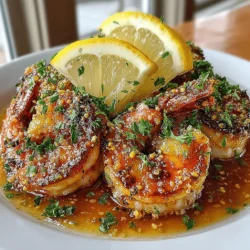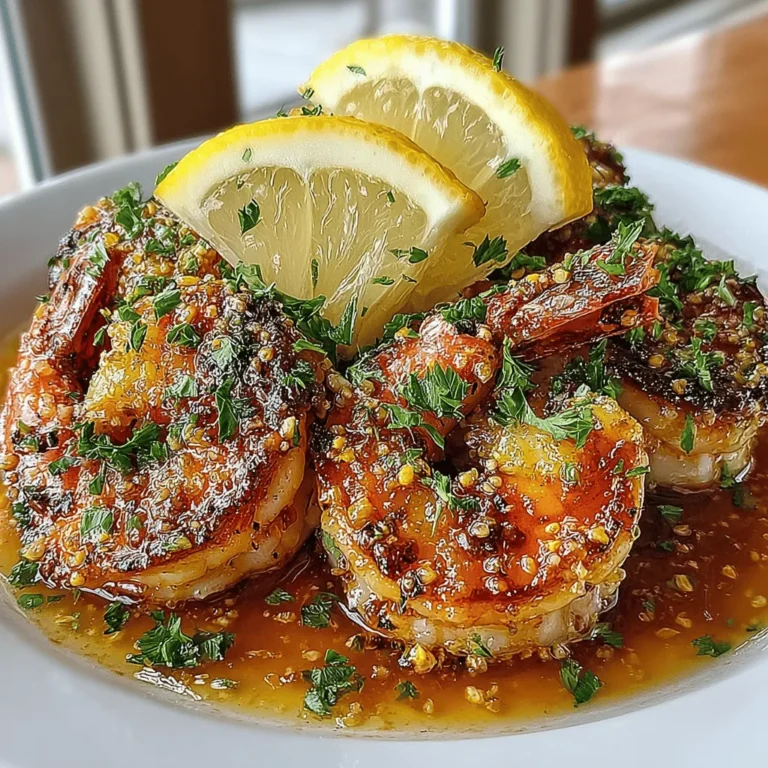Lemon Glazed Shrimp Recipe: A Deliciously Bright Dish
If you’re looking for a dish that combines tangy brightness with succulent seafood, look no further than lemon glazed shrimp. This delightful recipe not only embodies the flavors of fresh ingredients but also brings a vibrant twist to any meal. The combination of juicy shrimp, zesty lemon, and a hint of sweetness creates a harmonious balance that appeals to a wide range of palates. Whether you’re planning a weeknight dinner, hosting a gathering, or simply craving a light and refreshing meal, lemon glazed shrimp is an excellent choice that never disappoints.
The appeal of this dish lies in its versatility. It can be served as a main course alongside a bed of rice or fresh vegetables, or it can be a star in a seafood platter. The bright flavors also make it an ideal choice for summer barbecues or casual get-togethers. No matter the occasion, this dish is sure to impress your guests and family alike.
Understanding the Ingredients
To create the perfect lemon glazed shrimp, it’s essential to understand the key ingredients that contribute to its delightful flavor profile. Each component plays a vital role in crafting a dish that’s not only delicious but also nutritious.
Large Shrimp: The foundation of this recipe is, of course, the shrimp. Opting for large, high-quality shrimp is crucial, as their size allows for a satisfying bite and better absorption of flavors. Freshness is key; sourcing shrimp from reputable suppliers ensures that they are at their peak quality, contributing to the dish’s overall success.
Olive Oil: This ingredient serves as the base for the marinade. Not only does olive oil add a rich flavor, but it also provides numerous health benefits, including heart-healthy fats. When selecting olive oil, look for extra virgin varieties, as they offer the best flavor and nutritional value.
Garlic: Garlic is a staple in many culinary traditions, and for good reason. In this recipe, it enhances the taste and aroma, providing a savory depth that complements the sweetness of the shrimp. Fresh garlic, minced finely, will infuse the marinade beautifully.
Lemon: The true star of this dish is the lemon, which brings a bright acidity that elevates the shrimp. Both the zest and juice of the lemon are used in the marinade; the zest adds a concentrated burst of flavor, while the juice provides tanginess. Using fresh lemons rather than bottled juice will yield the best results in terms of taste.
Honey: To balance the acidity of the lemon, honey is introduced into the marinade. Its natural sweetness creates a delightful contrast, enhancing the overall flavor profile of the dish. Additionally, honey contributes a beautiful glaze when cooked, giving the shrimp a lovely finish.
Soy Sauce: A splash of soy sauce adds depth and umami, enriching the flavors without overpowering the dish. It also helps to tenderize the shrimp, making them even more succulent.
Red Pepper Flakes: For those who enjoy a bit of heat, red pepper flakes can be added to the marinade. This optional ingredient provides a pleasant kick that contrasts nicely with the sweetness and acidity.
The importance of using fresh and high-quality ingredients cannot be overstated. The vibrant flavors of the lemon, the richness of the olive oil, and the succulence of the shrimp all work together to create a dish that is not only visually appealing but also mouth-watering.
Preparation of Lemon Glazed Shrimp
Now that you have a solid grasp of the ingredients, it’s time to move on to the preparation of the lemon glazed shrimp. Preparing the marinade correctly is essential for achieving the best possible flavor.
Step 1: Making the Marinade
To start, gather all your ingredients: fresh lemon, large shrimp, olive oil, minced garlic, honey, soy sauce, and red pepper flakes (if using). In a medium bowl, combine the juice and zest of the lemon, olive oil, minced garlic, honey, soy sauce, and a pinch of red pepper flakes.
Step 2: Whisking to Combine
Using a whisk, blend the ingredients together until well combined. The whisking process is important as it helps to emulsify the olive oil with the other ingredients, ensuring that the flavors meld together beautifully.
Step 3: Preparing the Lemon
For the lemon, start by washing it thoroughly to remove any wax or pesticides. Use a microplane or fine grater to zest the lemon, being careful to avoid the bitter white pith beneath the skin. After zesting, cut the lemon in half and squeeze out the juice, removing any seeds that may fall in.
Step 4: Marinating the Shrimp
Once your marinade is ready, it’s time to marinate the shrimp. Place the cleaned and deveined shrimp in a resealable plastic bag or a shallow dish. Pour the marinade over the shrimp, making sure they are well coated. Seal the bag or cover the dish with plastic wrap.
Marination is crucial in this recipe as it allows the shrimp to absorb the flavors deeply. Ideally, you should let the shrimp marinate for at least 30 minutes. If time permits, marinating for up to two hours can enhance the flavor even further.
Step 5: Visual Cues
While marinating, keep an eye on the shrimp. They will start to turn a slightly opaque color as they soak in the marinade. This is a good indicator that they are absorbing the flavors and will be ready for cooking soon.
By following these steps, you’ll set the stage for cooking perfectly glazed shrimp that are bursting with flavor. The combination of fresh ingredients and careful preparation will ensure that your lemon glazed shrimp will be a hit at any gathering or a delightful addition to your weekly meal rotation.
Stay tuned for the next part, where we will delve into the cooking process and how to achieve that perfect glaze that makes this dish truly shine.
{{image_2}}
Lemon glazed shrimp is a delightful dish that combines the freshness of shrimp with a vibrant, tangy glaze that elevates any dining experience. This section will provide you with a detailed guide on how to cook the shrimp to perfection, create the glaze, serve it beautifully, and understand the nutritional benefits of this dish.
Step-by-Step Guide to Cooking the Shrimp
To achieve the perfect lemon glazed shrimp, following a precise cooking technique is crucial. Here’s how to do it:
1. Preheat the Skillet: Begin by preheating your skillet over medium-high heat for about 2-3 minutes. A hot skillet is essential for sealing in the shrimp’s juices, ensuring an even cook and preventing sticking.
2. Add Oil: Once the skillet is hot, add a tablespoon of olive oil. This oil not only helps in cooking but also adds flavor while keeping the shrimp moist.
3. Cook the Shrimp: Carefully add the shrimp to the skillet in a single layer. Avoid overcrowding the pan to ensure even cooking. Cook the shrimp for 2-3 minutes on one side without moving them to allow a nice sear to develop.
4. Flip the Shrimp: Use a spatula to flip the shrimp once they turn pink and opaque on one side. Cook for an additional 1-2 minutes on the other side.
5. Check for Doneness: The shrimp should be fully cooked when they are pink and opaque throughout, and their tails should curl slightly.
Importance of Preheating the Skillet for Even Cooking
Preheating your skillet is crucial for achieving that signature sear on your shrimp. When the skillet is hot enough, it creates a caramelization effect that enhances flavor and texture. If your skillet is not adequately heated, the shrimp may steam rather than sear, resulting in a rubbery texture.
Cooking Times for Shrimp to Achieve the Perfect Texture
The cooking time for shrimp is relatively short, typically ranging from 3-5 minutes total depending on their size. Large shrimp will take a bit longer, while smaller shrimp will cook faster. Be attentive and avoid overcooking, as shrimp can become tough and chewy if left in the pan for too long.
Techniques to Avoid Overcooking Shrimp
To prevent overcooking, consider these tips:
– Use Fresh Shrimp: Fresh shrimp cooks evenly and retains moisture better than frozen shrimp.
– Remove from Heat Early: Shrimp continue to cook even after being removed from heat, so take them off the skillet just before they reach the desired doneness.
– Use a Timer: Set a timer for each cooking stage to keep track of the time.
Signs That Shrimp Are Fully Cooked
The shrimp are done cooking when:
– They turn a bright pink color.
– Their flesh becomes opaque.
– They curl slightly, forming a C shape.
– If you cut one open, it should be white and not translucent.
How to Maintain a Glossy Finish
To maintain that glossy finish, once cooked, toss the shrimp quickly in the glaze while they are still warm. This will ensure that the glaze adheres well, giving the shrimp a beautiful sheen.
Creating the Glaze
The glaze is what truly transforms this dish into something special. Here’s how to create the perfect lemon glaze for your shrimp:
Explanation of Reducing the Marinade for a Thicker Glaze
After marinating the shrimp, you’ll have a flavorful liquid left over. This marinade can be transformed into a glaze by reducing it. Pour the marinade into the same skillet used for cooking the shrimp and bring it to a boil.
Why Reduction is Important for Flavor Concentration
Reducing the marinade is essential because it concentrates the flavors, resulting in a richer, more robust glaze. The process evaporates excess water, thickening the consistency and enhancing the lemony goodness.
How to Achieve the Perfect Syrupy Consistency
To achieve that perfect syrupy consistency:
– Allow the marinade to boil for 5-7 minutes, stirring occasionally until it thickens.
– Keep an eye on it to prevent burning; the goal is to reduce it to a glaze-like texture that can coat the back of a spoon.
Serving Suggestions
Once your lemon glazed shrimp are ready, it’s time to present them in a way that highlights their vibrant flavors.
Ideas for Plating the Lemon Glazed Shrimp
1. Over Rice: Serve the shrimp over a bed of fluffy jasmine or basmati rice. The rice will soak up the delicious glaze.
2. On a Bed of Greens: For a lighter option, place the shrimp on a fresh salad of mixed greens, cucumbers, and tomatoes.
3. With Grilled Vegetables: Accompany the shrimp with grilled zucchini, bell peppers, or asparagus for a colorful plate.
Suggested Accompaniments: Rice, Salads, and Vegetables
The lemon glazed shrimp pairs wonderfully with:
– Coconut Rice: The creamy texture of coconut rice complements the tangy glaze.
– Quinoa Salad: A quinoa salad with cherry tomatoes, avocado, and cilantro will add a nutritious touch.
– Steamed Broccoli: Simple steamed broccoli provides a healthy contrast and vibrant color.
Presentation Tips to Enhance Visual Appeal
To elevate the presentation:
– Use a white plate to contrast against the bright shrimp and garnish.
– Arrange the shrimp in a circle or stack them for height.
– Drizzle the glaze artistically around the plate for a gourmet look.
Importance of Garnishing with Fresh Parsley and Lemon Wedges
Garnishing is key to a beautiful dish. Fresh chopped parsley adds a pop of color and freshness, while lemon wedges not only enhance the visual appeal but also give guests the option to add more lemon flavor to their dish.
Nutritional Information
Understanding the nutritional benefits of your ingredients can help you appreciate this dish even more.
Overview of the Nutritional Benefits of the Ingredients
Lemon glazed shrimp is not only delicious but also packed with nutrients. Here’s a closer look at the health benefits:
– Shrimp: An excellent source of protein, shrimp is low in calories and high in essential nutrients like selenium and vitamin B12.
– Olive Oil: Rich in healthy monounsaturated fats, olive oil supports heart health and provides antioxidant properties.
– Garlic: Known for its numerous health benefits, garlic can boost the immune system and has anti-inflammatory properties.
Protein Content of Shrimp
A typical serving of shrimp (approximately 3 ounces) contains around 20 grams of protein, making it a great option for muscle building and repair.
Health Benefits of Olive Oil and Garlic
– Olive Oil: Besides being heart-healthy, it aids in reducing inflammation and lowering cholesterol levels.
– Garlic: Its active compounds can help in reducing blood pressure and improving cardiovascular health.
Caloric Considerations and Balance in the Meal
With shrimp being low in calories and the healthy fats from olive oil, this dish is a balanced option. It allows you to enjoy a flavorful meal without compromising on health, especially when paired with vegetables or whole grains.
Conclusion
Lemon glazed shrimp is a delightful dish that brings together vibrant flavors, nutrient-rich ingredients, and a beautiful presentation. The simplicity of the recipe allows for versatility, making it suitable for casual weeknight dinners or elegant dinner parties.
With its health benefits, including high protein content and heart-healthy fats, this dish is not only a treat for the taste buds but also a smart choice for your health. Whether you serve it over rice, alongside a fresh salad, or with grilled vegetables, lemon glazed shrimp is sure to impress your family and guests alike.
We encourage you to try this recipe and experience the delightful flavors and health benefits for yourself. Enjoy this culinary adventure, and don’t hesitate to experiment with your favorite side dishes or garnishes to make it your own!


